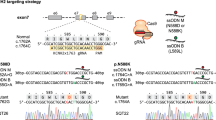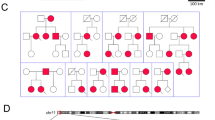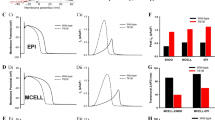Abstract
Mutations in cardiac potassium and sodium channel genes are responsible for several hereditary cardiac arrhythmia syndromes. We established a denaturing high-performance liquid chromatography (DHPLC) protocol for rapid mutation screening of these genes, and reported mutations and variations identified by this method. We included 28 patients with Brugada syndrome, 4 with congenital long QT syndrome (LQTS), 11 with drug-induced LQTS, 4 with idiopathic ventricular fibrillation, and 50 normal volunteers. Polymerase chain reactions were performed to amplify the entire coding region of these genes. DHPLC was used to screen for heteroduplexes then DNA sequencing was performed. With this method, we identified the mutation(s) in all four patients with congenital LQTS (KCNQ1 A341V, KCNH2 N633D, KCNH2 2768Cdel and KCNE1 K70 N Y81C double mutations). We also identified the SCN5A A551T mutation in 1 of the 28 patients with Brugada syndrome. All the above-mentioned mutations were novel except KCNQ1 A341V. No mutations were identified in patients with drug-induced LQTS or idiopathic ventricular fibrillation. In total, 25 single nucleotide polymorphisms were identified, 10 of which were novel. In conclusion, DHPLC is a sensitive and rapid method for detection of cardiac sodium and potassium channel gene mutations.
Similar content being viewed by others
Log in or create a free account to read this content
Gain free access to this article, as well as selected content from this journal and more on nature.com
or
References
Abitbol I, Peretz A, Lerche C, Busch AE, Attali B (1999) Stilbenes and fenamates rescue the loss of IKS channel function induced by an LQT5 mutation and other IsK mutants. EMBO J 18:4137–4148
Akimoto K, Furutani M, Imamura S, Furutani Y, Kasanuki H, Takao A, Momma K, Matsuoka R (1998) Novel missense mutation (G601S) of HERG in a Japanese long QT syndrome family. Hum Mutat 1:S184–S186
Chen JZ, Xie XD, Wang XX, Tao M, Shang YP, Guo XG (2004) Single nucleotide polymorphisms of the SCN5A gene in Han Chinese and their relation with Brugada syndrome. Chin Med J 117:652–656
Itoh T, Tanaka T, Nagai R, Kamiya T, Sawayama T, Nakayama T, Tomoike H, Sakurada H, Yazaki Y, Nakamura Y (1998) Genomic organisation and mutational analysis of HERG, a gene responsible for familial long QT syndrome. Hum Genet 102:435–439
Iwasa H, Itoh T, Nagai R, Nakamura Y, Tanaka T (2000) Twenty single nucleotide polymorphisms (SNPs) and their allelic frequencies in four genes that are responsible for familial long QT syndrome in the Japanese population. J Hum Genet 45:182–183
Jongbloed R, Marcelis C, Velter C, Doevendans P, Geraedts J, Smeets H (2002) DHPLC analysis of potassium ion channel genes in congenital long QT syndrome. Hum Mutat 20:382–391
Lai LP, Deng CL, Moss AJ, Kass RS, Liang CS (1994) Polymorphism of the gene encoding a human minimal potassium ion channel (minK). Gene 151:339–340
Lai LP, Su MJ, Lin JL, Hwang JJ, Tseng YZ, Lien WP, Huang SKS (2000) A study on two kinds of human minK proteins: electrophysiological and pharmacological properties and incidence in the Chinese population. Acta Cardiol Sinica 16:221–228
Larsen LA, Christiansen M, Vuust J, Andersen PS (1999) High-throughput single-strand conformation polymorphism analysis by automated capillary electrophoresis: robust multiplex analysis and pattern-based identification of allelic variants. Hum Mutat 13:318–327
Larsen LA, Andersen PS, Kanters J, Svendsen IH, Jacobsen JR, Vuust J, Wettrell G, Tranebjaerg L, Bathen J, Christiansen M (2001) Screening for mutations and polymorphisms in the genes KCNH2 and KCNE2 encoding the cardiac HERG/MiRP1 ion channel: implications for acquired and congenital long Q-T syndrome. Clin Chem 47:1390–1395
Lee MP, Hu RJ, Johnson LA, Feinberg AP (1997) Human KVLQT1 gene shows tissue-specific imprinting and encompasses Beckwith-Wiedemann syndrome chromosomal rearrangements. Nat Genet 5:181–185
Makielski JC, Ye B, Valdivia CR, Pagel MD, Pu J, Tester DJ, Ackerman MJ (2003) A ubiquitous splice variant and a common polymorphism affect heterologous expression of recombinant human SCN5A heart sodium channels. Circ Res 93:821–828
Mok NS, Priori SG, Napolitano C, Chan KK, Bloise R, Chan HW, Fung WH, Chan YS, Chan WK, Lam C, Chan NY, Tsang HH (2004) Clinical profile and genetic basis of Brugada syndrome in the Chinese population. Hong Kong Med J 10:32–37
Orita M, Iwahana H, Kanazawa H, Hayashi K, Sekiya T (1989) Detection of polymorphisms of human DNA by gel electrophoresis as single-strand conformation polymorphisms. Proc Natl Acad Sci USA 86:2766–2770
Paulussen AD, Gilissen RA, Armstrong M, Doevendans PA, Verhasselt P, Smeets HJ, Schulze-Bahr E, Haverkamp W, Breithardt G, Cohen N, Aerssens J (2004) Genetic variations of KCNQ1, KCNH2, SCN5A, KCNE1, and KCNE2 in drug-induced long QT syndrome patients. J Mol Med 82:182–188
Priori SG (2004) Inherited arrhythmogenic diseases: the complexity beyond monogenic disorders. Circ Res 94:140–145
Priori SG, Napolitano C, Gasparini M, Pappone C, Della Bella P, Brignole M, Giordano U, Giovannini T, Menozzi C, Bloise R, Crotti L, Terreni L, Schwartz PJ (2000) Clinical and genetic heterogeneity of right bundle branch block and ST-segment elevation syndrome: a prospective evaluation of 52 families. Circulation 102:2509–2515
Satler CA, Vesely MR, Duggal P, Ginsburg GS, Beggs AH (1998) Multiple different missense mutations in the pore region of HERG in patients with long QT syndrome. Hum Genet 102:265–272
Schulze-Bahr E, Eckardt L, Breithardt G, Seidl K, Wichter T, Wolpert C, Borggrefe M, Haverkamp W (2003) Sodium channel gene (SCN5A) mutations in 44 index patients with Brugada syndrome: different incidences in familial and sporadic disease. Hum Mutat 21:651–652
Splawski I, Shen J, Timothy KW, Lehmann MH, Priori S, Robinson JL, Moss AJ, Schwartz PJ, Towbin JA, Vincent GM, Keating MT (2000) Spectrum of mutations in long-QT syndrome genes KVLQT1, HERG, SCN5A, KCNE1, and KCNE2. Circulation 102:1178–1185
Splawski I, Timothy KW, Tateyama M, Clancy CE, Malhotra A, Beggs AH, Cappuccio FP, Sagnella GA, Kass RS, Keating MT (2002) Variant of SCN5A sodium channel implicated in risk of cardiac arrhythmia. Science 297:1333–1336
Syrris P, Murray A, Carter ND, McKenna WM, Jeffery S (2001) Mutation detection in long QT syndrome: a comprehensive set of primers and PCR conditions. J Med Genet 38:705–710
Takahata T, Yasui-Furukori N, Sasaki S, Igarashi T, Okumura K, Munakata A, Tateishi T (2003) Nucleotide changes in the translated region of SCN5A from Japanese patients with Brugada syndrome and control subjects. Life Sci 72:2391–2399
Viswanathan PC, Benson DW, Balser JR (2003) A common SCN5A polymorphism modulates the biophysical effects of an SCN5A mutation. J Clin Invest 111:341–346
Wang Q, Shen J, Splawski I, Atkinson D, Li Z, Robinson JL, Moss AJ, Towbin JA, Keating MT (1995) SCN5A mutations associated with an inherited cardiac arrhythmia, long QT syndrome. Cell 80:805–811
Xiao W, Oefner PJ (2001) Denaturing high-performance liquid chromatography: a review. Hum Mutat 17:439–474
Yang P, Kanki H, Drolet B, Yang T, Wei J, Viswanathan PC, Hohnloser SH, Shimizu W, Schwartz PJ, Stanton M, Murray KT, Norris K, George AL Jr, Roden DM (2002) Allelic variants in long-QT disease genes in patients with drug-associated torsades de pointes. Circulation 105:1943–1948
Ye B, Valdivia CR, Ackerman MJ, Makielski JC (2003) A common human SCN5A polymorphism modifies expression of an arrhythmia causing mutation. Physiol Genomics 12:187–193
Acknowledgements
This study was supported by grants DOH92-TD-1060, DOH93-TD-G-113-001 and DOH94-TD-G-113-001 from the Department of Health and grant NTUH-92-S006 from the National Taiwan University Hospital.
Author information
Authors and Affiliations
Corresponding author
Additional information
An erratum to this article can be found at http://dx.doi.org/10.1007/s10038-006-0367-8
Ling-Ping Lai and Yi-Ning Su contributed equally to this manuscript
Electronic Supplementary Material
Rights and permissions
About this article
Cite this article
Lai, LP., Su, YN., Chiang, FT. et al. Denaturing high-performance liquid chromatography screening of the long QT syndrome-related cardiac sodium and potassium channel genes and identification of novel mutations and single nucleotide polymorphisms. J Hum Genet 50, 490–496 (2005). https://doi.org/10.1007/s10038-005-0283-3
Received:
Accepted:
Published:
Issue date:
DOI: https://doi.org/10.1007/s10038-005-0283-3
Keywords
This article is cited by
-
KCNE1 divides the voltage sensor movement in KCNQ1/KCNE1 channels into two steps
Nature Communications (2014)
-
Mutations in Danish patients with long QT syndrome and the identification of a large founder family with p.F29L in KCNH2
BMC Medical Genetics (2014)
-
A simplified, non-invasive fecal-based DNA integrity assay and iFOBT for colorectal cancer detection
International Journal of Colorectal Disease (2011)
-
Characterization of a novel Nav1.5 channel mutation, A551T, associated with Brugada syndrome
Journal of Biomedical Science (2009)
-
Heterozygous nonsense SCN5A mutation W822X explains a simultaneous sudden infant death syndrome
Virchows Archiv (2008)



